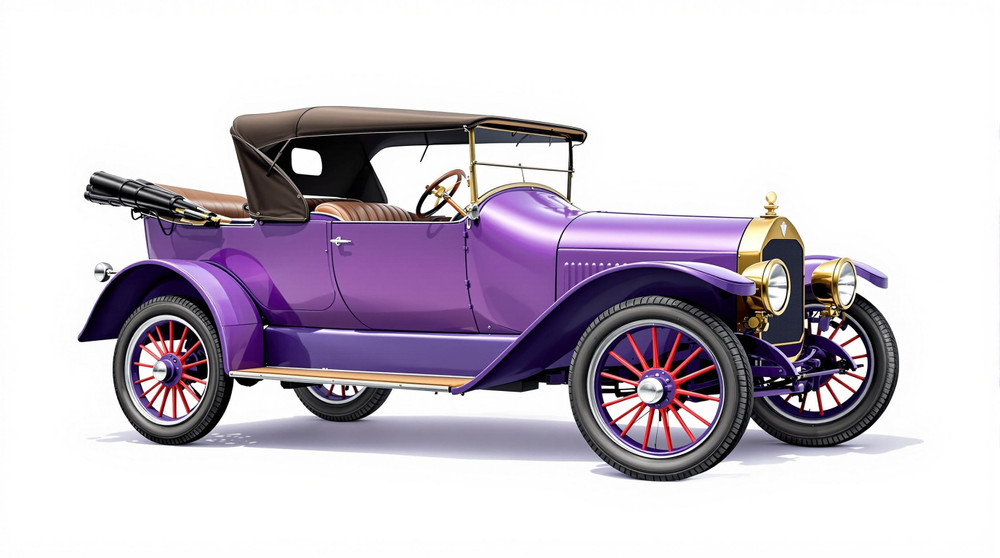Image of 1913 Buick Model 24, Note: These illustrations use artistic license and may differ from actual historical models.
Performance Metrics
Fundamental Metrics
Emotional Appeal
MMP Rating
| Engine Specifications | |
|---|---|
| Engine: | 4-cylinder, in-line |
| Displacement: | 165 cubic inches |
| Horsepower: | Estimated 22-24 HP |
| Torque: | Not available |
| Compression Ratio: | Not available |
| Ignition System: | Magneto |
| Cooling System: | Water-cooled |
| Performance Specifications | |
| 0-60 Time: | Not available |
| 1/4 Mile Time: | Not available |
| Top Speed: | 40-45 mph |
| Transmission and Drive | |
| Drive Type: | Rear-wheel drive |
| Transmission Type: | 3-speed manual |
| Fuel and Efficiency | |
| Fuel System Type: | Carburetor |
| MPG: | Not available |
| Dimensions and Brakes | |
| Brakes: | Mechanical drum brakes |
| Wheelbase: | 100 inches |
| Weight: | 1,650 lbs |
Note: Specifications for classic cars are given to the best of our ability, considering the limited and variant data available.
Unveiling the 1913 Buick Model 24: A Century-Old Marvel
Step into the realm of vintage elegance where the 1913 Buick Model 24 resides as a testament to early automotive innovation. Born from the inventive minds at Buick, a company already carving its niche in the burgeoning car industry, this model emerged at a time when automobiles were transitioning from novelties to necessities. The Model 24, with its unique blend of style and engineering, became a symbol of status and technological advancement. Its legacy is punctuated by the fact that it was one of the earliest cars to feature electric lights—a luxury in its day.
Design and Innovation
The 1913 Buick Model 24 boasted an exterior that exuded charm and confidence. Its sweeping curves and brass accents commanded attention on every boulevard. The interior was a sanctuary of craftsmanship, with materials chosen for durability and comfort. Technologically, it stood out with features like an electric starter, which was a groundbreaking convenience at the time. Color options were limited in this era, but Buick's rich blues and deep blacks were among the most sought after. The Model 24 came in various body styles, with the roadster variant being particularly iconic for its sporty open-air appeal.
Historical Significance
This automobile didn't just transport people; it transported ideas. The 1913 Buick Model 24 was pivotal in setting new standards for what motorists could expect from their vehicles. It distinguished itself from competitors with a robust overhead valve engine—a design choice that would influence automotive engineering for decades to come.
Performance and Handling
Under the hood, the Model 24's performance was respectable for its time, with a top speed that could thrill contemporary drivers. Acceleration was measured not in seconds but in patience and anticipation. Handling was an art form, as drivers navigated varying road conditions without power steering or modern suspension—feeling every nuance of the journey. The engine's hum was a mechanical symphony complementing the tactile feedback from the road below.
Ownership Experience
The 1913 Buick Model 24 served multiple roles—from daily transportation to weekend leisure driving. Maintenance required a hands-on approach, but its mechanical simplicity meant that many owners could perform repairs themselves. Reliability was a hallmark of Buick's engineering ethos even then.
Fun Facts
This centenarian on wheels has seen more history than most libraries, including surviving two world wars and witnessing the dawn of modern civilization. While not known for breaking speed records, it broke barriers of accessibility and luxury in motoring. Criticisms were few but often pointed at its then-premium price point or fuel efficiency by today's standards.
Collector's Information
The current value range for a well-preserved or restored 1913 Buick Model 24 can be quite broad due to its historical significance and condition variance. Rarity is unquestionable; estimates suggest that only a few hundred might have survived to this day. As for appreciation, vehicles like this often see an upward trend due to their scarcity and historical value—prices can range significantly into six figures depending on provenance and originality.
Conclusion
The 1913 Buick Model 24 is more than just an antique; it's a rolling chronicle of automotive progress. Owning one is owning a piece of history—a narrative woven into the fabric of early twentieth-century innovation. As we look back over a century later, the Model 24 stands as a proud ancestor to today's vehicles, reminding us of how far we've traveled on the roads paved by pioneers.
1913 Buick Model 24 Catalog of Parts
 1913 Buick MODEL 24 Clutch and Brake Pedal Pads. 2-3/4" wide X 3-3/8" long-CB 12Clutch and Brake Pedal Pads. 2-3/4" wide X 3-3/8" long. Pair
1913 Buick MODEL 24 Clutch and Brake Pedal Pads. 2-3/4" wide X 3-3/8" long-CB 12Clutch and Brake Pedal Pads. 2-3/4" wide X 3-3/8" long. Pair 1913 Buick MODEL 24 Clutch and Brake Pedal Pads. 2-3/4" wide X 3-3/4" long-CB 13Clutch and Brake Pedal Pads. 2-3/4" wide X 3-3/4" long. Pair
1913 Buick MODEL 24 Clutch and Brake Pedal Pads. 2-3/4" wide X 3-3/4" long-CB 13Clutch and Brake Pedal Pads. 2-3/4" wide X 3-3/4" long. PairWhy Choose Metro?
For over 100 years, Metro Moulded Parts has been the pinnacle of quality in classic car restoration parts. Our commitment to precision and authenticity in every component ensures a perfect fit and an OEM-level appearance.
- Expert Craftsmanship & Quality: Each part is a testament to our dedication to reliability and perfection, crafted from original designs and thoroughly tested.
- Advanced Technology: We use cutting-edge techniques to create flawless, long-lasting parts that surpass others in performance.
- SuperSoft Sponge – The Ultimate Door Seal: Not only are our door seals 30% softer than competitors', but they're also guaranteed to never leak. They effectively reduce wind and road noise, enhancing your classic car's comfort and driving experience.
- Proudly American: Our parts are a product of American craftsmanship, made in the USA with a spirit of excellence and heritage.
- Unrivaled Warranty: We back our products with a 30-year industry-leading warranty, a testament to our confidence in their quality.
Join us in preserving the legacy of classic cars with parts that are crafted for perfection, not just made.

